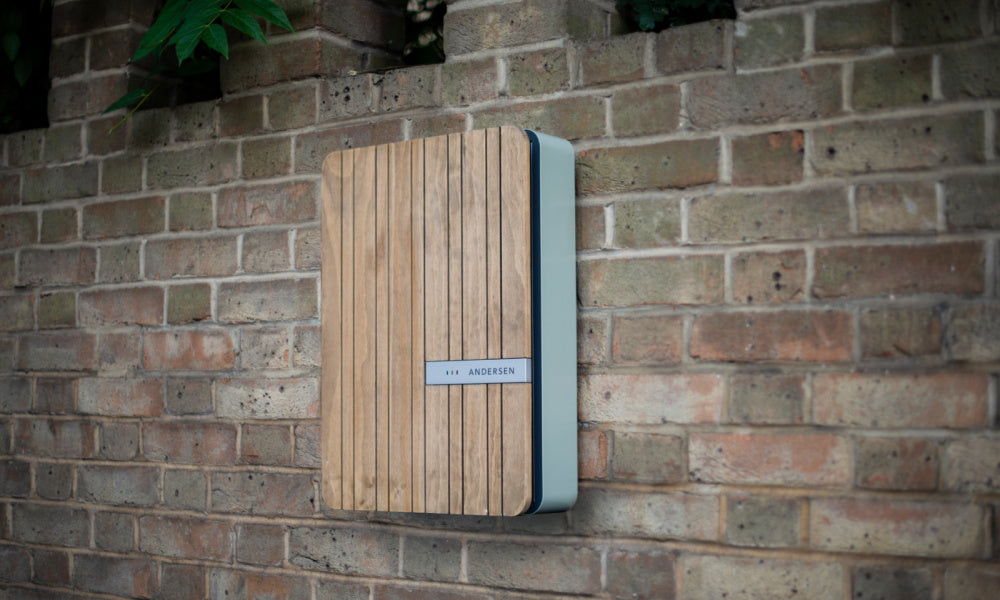If you’re thinking about making the leap to electric and purchasing a new electric vehicle, then installing a charging point at home is probably high on your agenda. But, before you go out and order one, read this complete guide to buying an EV charger for your home from the Andersen EV team first…
Home EV charger definition
A home EV charger - which can also be called an EV charging point, EV charging station, charge point, wallbox charger, electric vehicle supply equipment (or multiple variations thereof) - is a device which is designed to charge electric vehicles.
Home EV chargers are installed at domestic properties to provide a convenient and easy way of charging electric vehicles when they’re not in use.
Typically, wall-mounted (or occasionally placed on a charging stand), home EV chargers are available with varying power outputs, myriad smart features, different aesthetics, cable types and more.
The key things to consider when buying a home EV charger
When it comes to selecting the perfect EV charger for your home, there are multiple factors that you’ll need to consider.
These factors include:
- The charger’s power rating.
- Whether the charger is tethered or untethered.
- The type of plug the charger has.
- Compatibility.
- Installation considerations.
- Whether the charger has smart features or not.
- The type of power connection in your home.
- Price.
- Design and aesthetics.
- Warranty and support.

Home EV charger buying guide
Below, we’ll guide you through each of the buying considerations bulleted above to ensure you are able to select the perfect EV charger for your home.
We’ll also cover the frequently asked questions about EV chargers that we regularly receive here at Andersen EV.
Home EV charger power rating
This is arguably the most important part of buying an EV charger for your home, as the power rating of your charger will determine how quickly it takes for your car to be fully charged.
In general, the home EV chargers that are available on the UK market will be one of three different power ratings:
- 3.6kW.
- 7kW.
- 22kW (only for homes with three-phase electricity connection).
Note - you may see mention of 50kW and even 100kW chargers around the web. However, these are only used for charging at motorway service stations etc and aren’t installed at domestic properties.
3.6kW chargers for EVs
3.6kW chargers are the slowest type of home EV charger that you can buy. It’s for this reason that they’re very uncommon and rarely installed at homes.
According to the RAC, a 3.6kW home charger can take anywhere between six and 12 hours to charge a car. That’s fine if you’re only intending to do low mileage, and you have a car with a smaller capacity battery.
However, if you have a higher performance EV, and also want to be able to charge your car more rapidly, then you’ll want to select a charger with a higher power output.
7kW chargers for EVs
7kWs chargers are considered to be ‘fast chargers’ and have rapidly become the standard option for the majority of UK homeowners.
This is because they considerably speed up the charging process, generally being able to charge an EV from empty to full in around four to six hours (naturally, this will vary depending on your individual car and it’s battery capacity).
Due to the popularity of 7kW home chargers, their cost has decreased considerably in recent years, with some chargers now being not much more expensive than 3.6kW chargers.
7kW chargers also have the benefit of being able to be used with a single-phase electricity connection (which is what most UK homes have). As a result, they are straightforward to install.
22kW chargers for EVs
As you’ve probably guessed, 22kW chargers offer the very fastest charging times for EVs and represent the future of EV charging.
On average, a 22kW charger will be able to charge an EV from empty to full charge in as little as one to two hours; however, this will depend on your exact car and its battery capacity.
However, at present, adoption of 22kW chargers is somewhat limited because of a particular factor. 22kW chargers require a three-phase power supply. At present, only a limited number of homes have a three-phase supply (we’ll tell you how to identify what kind of connection your home has later on in this article).
It’s for this reason that many businesses with EV charging points will use 22kW chargers, as many commercial properties are fitted with three-phase power supplies.
AC vs DC electrical charging
When selecting an EV charger for your home, there’s an important piece of information you need to know. That is, the difference between AC and DC electrical charging.
UK homes are powered using AC (which stands for Alternative Current). However, electric vehicles use DC (Direct Current).
If you select a 3.6kW, 7kW, or 22kW charger, it’s likely that they will charge your car using an AC current. Your EV will use its OBC (On Board Charging) system to convert that AC current into DC for its battery.
Although it’s possible to buy DC-based EV charging points, these are currently extremely expensive and are typically only installed in commercial environments such as petrol stations/public charging stations.
Note - most EV OBC systems can only handle up to a maximum of 22kW.

The type of power connection in your home
As you may have gathered, the type of EV charger you can buy (in terms of its power output), will be largely determined by the type of power connection your home has.
Homes in the UK will have either:
- A single-phase electricity connection.
Or
- A three-phase electricity connection.
Below, we’ve explained a little more about each of these electricity connection types.
What is a single-phase electricity connection?
Put simply, a single-phase electricity connection is an electricity network that has a single live wire.
A single-phase electricity network is used to distribute alternating current (AC) and uses two wires; one ‘live’ power wire, and one neutral wire.
What is a three-phase electricity connection?
By contrast, a three-phase electricity connection is an electricity network that uses three ‘live’ wires to distribute alternating current (AC) power.
Three-phase connections deliver electricity in a much more consistent, steadier and linear way than single-phase connections. As such, they are much more suited to transmitting higher loads of electricity than single-phase connections.
It’s for this reason that your home requires a three-phase electricity connection if you want to use an EV charger with a power output of 22kW.
Although the majority of UK homes are served by a three-phase electricity network, most homes are only connected to a single live wire from the three-phase network. So, although in theory they may be connected to a three-phase network, in reality they only have a single-phase connection.
How to tell if you have a single-phase or three-phase connection?
If you want to know if you can buy a 22kW EV charger, or if you have to stick to a 7kW (or lower) charger, then you’ll need to figure out what type of electricity connection to the grid your home has.
The majority of homes in the UK have a single-phase electricity connection. Three-phase connections are typically found in larger properties which have a higher demand for electricity.
Generally, the easiest way to figure out what type of electricity connection you have is to look in your electric meter cupboard. If you have a three-phase connection, then you’ll see three main fuses as opposed to only one 100 amp fuse.
If you’re still not sure after looking in your meter cupboard, then feel free to send us a photograph of your meter, and we’ll be able to tell you what connection type you have.
Tethered or untethered EV charger?
Once you’ve decided what power rating you want, the next step is to consider whether you want an untethered or tethered home EV charger.
Below, we’ve outlined what each of these terms means.
What is a tethered EV charger?
A tethered EV charger is simply a charger which has a charge cable permanently attached to it - hence the word ‘tethered’.
Tethered EV chargers have quickly become the most popular choice for UK homeowners, as having the charging cable permanently attached to the charger is much more convenient. All you need to do is uncoil the cable and plug it into your EV. Simple!
Here at Andersen EV, we’ve taken tethered EV chargers a step further with our unique and innovative ‘hidden cable technology’.
Whereas other tethered EV chargers require you to coil up the cable and in the process usually get your hands slightly wet or dirty, our Andersen A2 charger allows you to neatly and discreetly uncoil and coil the charging cable. What’s more, the Andersen A2’s Evoflek charging cable is the lightest and most flexible in the EV charging industry.
It’s both an aesthetically pleasing and practical solution.

What is an untethered EV charger?
An untethered EV charger is a charger where the charging cable can be decoupled (or ‘untethered’) from the charger.
Untethered EV chargers are something of a rare species these days, as they are hangovers from the days when electric vehicles used different types of plugs. They also have the inconvenience of requiring you to purchase an extra cable. You also have to continually take the cable out of the boot of your car every time you want to charge up.
Older electric vehicles used what are known as ‘Type 1’ sockets. However, since 2014 the European Union has mandated that all EVs must use a ‘Type 2’ socket.
As a result, untethered EV chargers are becoming rarer as there are fewer EVs on the road that may need to swap out the charger’s cable for a Type 1 plug.
EV charger plug type
Related to the above point, you should check what type of plug your chosen EV charger comes with.
There are currently three main types of sockets found on EVs:
-
Type 1 - also called J1772, Type 1 sockets have been largely phased out, although they can still be found on some models of Nissan Leaf.
-
Type 2 - since 2014, Type 2 sockets have been mandated on all new EVs in the EU and as such are pretty ubiquitous.
- CCS2 - this is a newer type of socket (CCS stands for Combined Charging System) that’s starting to be seen on many European EVs. This socket features a Type 2 socket on its top half and a DC connector below it. This means EVs with this type of socket can plug into both Type 2 chargers and rapid and ultra-rapid DC chargers.
To put it simply, near enough every charger on the market now features a Type 2 socket. All Andersen A2 chargers feature a Type 2 socket.
As such, if you own a much older electric vehicle - and it has a Type 1 socket - then you should be particularly vigilant when choosing a charger. It’s worth noting though that the only two cars in the UK that have this type of socket are the (older generation) Nissan Leaf and the Mitsubishi PHEV - so it’s not a problem many people have to worry about.
Compatibility
Although the majority of EV chargers are moving to a universal model, i.e. they can be used to charge any electric vehicle - you should always double-check that your chosen charger is compatible with your car.
Here at Andersen EV, our Andersen A2 home charging point is compatible with all electric vehicles that have a Type 2 socket.
Note - although our charging points are universal, we have forged brand-specific partnerships and are the recommended charging installer for Porsche GB and the official charging partner to Jaguar Land Rover.

Installation considerations
Another important point to consider when choosing a home EV charger is how and where it will be installed.
Below, we’ve set out some of the installation points you’ll want to give some thought to.
Hidden or viewable?
Do you want your home EV charger to be tucked away and hidden from sight? Or are you happy for it to be on full display for the whole world to see?
Here at Andersen EV, we design what we consider to be the most beautiful, best-looking home EV chargers on the market.
In fact, if you buy an Andersen A2, you’ll almost certainly want to show it off!
We offer 96 different colour options as well as a series of Accoya wood finishes.
Where is your EV’s charging port?
Although many EVs locate their charging port where you’d normally expect to find a petrol or diesel filling cap, that isn’t always the case.
If your EV’s charging port is located on the front of the car or some other position, you may want to install your EV charger in a more convenient location for easy access etc.

Installation location
As many home EV chargers must be wall-mounted in a vertical position, you’ll need to install your EV on a suitable fixed and sturdy surface, such as a brick wall.
Temporary surfaces such as wooden fences are not suitable installation locations for EV chargers. However, it is possible to get a dedicated pedestal if you don’t have a suitable structure to attach your charger to (it’s something we help customer with when required).
You will also need to ensure that the position you choose provides enough clearance to coil and uncoil the charger’s cable. For example, the Andersen A2 charger requires clearance of 500 mm on both sides of the unit to allow suitable access to the cable.
In order to make your chosen charger easier to use, you should also install it at a suitable height. You also want to ensure that it is not placed near the floor in case flooding occurs.
Note - there are electrical standards set out by the NICEIC which set out how EV chargers should be installed.
What is the length of the charging cable?
Depending on the length, size and overall dimensions of your driveway, you may need your EV charger to have a cable of a particular length.
Be sure to take some measurements with your car parked in its usual spot before you commit to a purchase.
The Andersen A2 can be selected with 5.5 m, 8.5 m (7kW), or 6.5 m (22kW) length charging cable.
Note - our cables are suitable for practically every type of installation. As the image above shows, these cable lengths are longer than most people think!
Access to Wi-Fi
You may not have expected to see Wi-Fi mentioned in this section of the article, but if you’re selecting an EV charger which has smart features, then it may need to connect to your home’s Wi-Fi network.
As such, you’ll want to select an installation point that isn’t too far away from your home’s Wi-Fi router. Having said that, if your installation point is a little too far away from your home’s router, Andersen EV is able to install a Wi-Fi booster.
Who will be carrying out the installation?
You should also think about who will be carrying out the installation. It’s not possible to install a home EV charger yourself (unless you are a suitably qualified electrician).
In many cases, you can either choose to install the charge point with your own electrician, or the charge point company will offer an installation service.
At Andersen EV, we offer both options. You can buy the Andersen A2 and have it installed by your own local electrician, or we can install it for you.
Smart charging
Due to a law that was passed in 2021 (The Electric Vehicles (Smart Charge Points) Regulations 2021), EV chargers intended for the private charging of EVs, need to have a ‘smart charging’ functionality.
This smart charging functionality will allow the charger to schedule charging at certain times of day (e.g. to take advantage of off-peak electricity rates).
EV chargers with smart charging functionality will typically come with an app which allows you to control the smart charging element from your smartphone.
Some EV chargers also allow scheduling of charging to take place during times of the day when there is likely to be much more renewable energy being supplied into the grid, e.g. midday during the summer or very windy days. This is a useful function if you’re particularly concerned about the environment.
The Andersen A2 is one such example of an EV charging unit that employs smart charging technology. Not only is it compliant with all smart charging regulations, but it allows you to charge your EV using solar energy (if you have solar panels installed on your home).
Smart functions
In addition to the ability to charge in an intelligent fashion, many EV chargers include smart functions. These vary from model to model, but can include things like:
- Remote locking - allowing you to provide access for other people to use your charger when you’re not at home.
- Monitor energy usage - providing real-time data of how much energy you’ve used.
- Track charging costs - providing a cost summary of every charging session.
The Andersen A2 possesses these and many other smart features.
Weatherproofing
As your EV charger is almost certainly going to be located outside, you should ensure that the charger you select is appropriately weatherproofed.
Although you should check how well weatherproofed the entire charging unit is, it’s particularly important to check how well weatherproofed the charger’s plug unit is. This is because this is the one part of an EV charger that is most susceptible to water ingress and other weather damage.
To assess how well weatherproofed an EV charger plug is, you should check its IP rating.
IP stands for ‘ingress protection’, with the IP Code measuring how well a device is protected against water and dust.
When a device has been assessed against the IP Code, it will receive a score which is set out as the letters ‘IP’ followed by two numbers, e.g. IP44.
The first of these two numbers will always be a number between 0 and 6, and indicates how well protected the device is against ingress of solid objects (e.g. dust or dirt).
The second of these two numbers will always be a number between 0 and 9, and denotes how well protected the device is against ingress of moisture.
Note - the Andersen A2’s main enclosure, core and plug compartment is IP65 rated, whilst the plug has an IP rating of IP44 (which only applies if the protective rubber cap is fully secured onto the plug when the charge point is not in use). To put this into context, the iPhone 14 has an IP rating of IP68.

Price
Of course, no purchasing decision is complete without consideration of the price.
The cost of electric car home chargers varies considerably and is influenced by multiple factors including the charger’s power output, features, design and more.
When choosing a home EV charger, don’t forget to factor in the cost of installation to your overall purchase price.
You should also consider the wider context in which you will be placing your chosen EV charger.
For example, you are likely to be installing your new EV charger on the front of your home. Sure, you could save money buying a cheaper charger, but then you’ll be stuck with an ugly plastic box defacing the front of your property.
Given that even minor details can drastically affect house prices, a premium EV charger which is finished in high-quality materials and which has a sympathetic aesthetic is usually a much wiser choice.
The Andersen A2 - which is available in 96 different colour options, is manufactured in the UK with high-quality materials - starts from only £1,199 (correct at the time of writing (March 2023), and subject to change).
The Andersen A2 was designed to be the most aesthetically pleasing EV charger on the market - which is why it’s positioned at the ‘premium’ end of the scale. Available in over 96 different colours and with a selection of beautiful accoya wood finishes, and packed with smart features, the A2 is the very best home EV charger you can buy.
Design and aesthetics
As we’ve just stated above, price and aesthetics are closely related when it comes to home EV chargers - so you should certainly consider the aesthetics and ‘curb appeal’ of an EV charger when you’re choosing one.
Cheaper EV chargers tend to be finished with basic plastic casings, which appear rather functional and utilitarian. In the worst instances, cheap EV chargers can actually detract from the overall look and feel of your home.
That’s why you should give some serious thought to the design of your EV charger rather than focusing solely on price.
Look at things like the materials used - is the charger manufactured using high-quality metals? Take a close look at the craftsmanship - where has the EV charger been manufactured?

It can also pay to look at case studies and the brands and people that are recommending particular EV chargers.
Here at Andersen EV, we recognised that EV chargers just weren’t up to scratch from an aesthetic and design point of view. After all, who wants to plug their luxury EV into a tacky plastic box?!
So, we set out to design an EV charger that wouldn’t merely complement your home’s look and feel, but actively enhance it.
The range of finishes and customisation options on our Andersen A2 charge point is vast. Aside from the finishes available, our designers have also put considerable thought into making the A2 a joy to use.
Simple, elegant touches such as the discrete dimensions of the unit, the hidden cable, the courtesy light and automatic cleaning of the cable all combine to make the A2 the premium home EV charging solution.
Don’t just take our word for it, though. Such is the regard in which the A2 is held, that premium luxury car brands such as Porsche have appointed Andersen EV as their recommended charging installer.
Tip - if you’d like to see what the Andersen A2 would look like on your home, use the Andersen AR Tool.
Warranty and support
Finally, when you’re looking for a home EV charger, be sure to check if your chosen model comes with a warranty and support.
As a general rule, you’ll find that the majority of home EV chargers come with a warranty from one to three years.
The Andersen A2 comes with three years of Andersen care cover (subject to warranty terms). This is much longer than the warranties offered by many other EV charger manufacturers.
The Andersen A2 is also made right here in the UK, by a team of skilled, time-served professionals. When you buy Andersen, you can be assured you’re getting the very best EV charger on the market.
Home EV charger FAQs
We hope the points above will help you select the perfect EV charger for your home.
However, that’s not all. There are many questions we receive from regular prospective customers, so we’ve set out these - and the answers - below.

Do I need a home EV charger? What are the benefits of installing an EV charger at home?
Well, naturally, we’re going to say yes, you do need a home EV charger. But, we’re not just saying that out of self-interest. There are a number of very good reasons why you should install an EV charger at your home.
Cost-effective
Installing a charger at home allows you to charge your EV overnight when electricity rates are far cheaper than during the daytime. Likewise, charging your car at home is often far cheaper than relying on commercial charging points.
Even better, if you have solar panels installed on the roof of your home, then some models of EV charger (like the Andersen A2), allow you to charge your EV using the sun. In the long run, that works out to be incredibly cost-effective.
Convenient
Being able to charge your EV at home is far more convenient than having to find a charging point around town.
Plus, having your very own charging point at home eliminates the worry around trying to find a vacant charging station when you’re out and about in your car.
Increased home value
As more and more of the UK population transition towards electric vehicles, having a dedicated charging point at your home is being seen as increasingly desirable.
In fact, according to various sources, having an EV charging station installed at your home could increase your property’s overall value by approximately £10k!
Can I plug my car into a standard UK home plug socket?
If the benefits above aren’t enough to convince you to install an EV charging point at home, consider the alternative - trying to charge your EV using a traditional plug socket.
Yes, it’s technically possible to do this and charge your car using a standard three-pin socket - but the reality is you really won’t want to.
Why? Because of the sheer amount of time it takes.
To charge your average electric car using a normal plug socket can take in excess of 35 hours. Nobody has time for that!
What’s the difference between slow, fast, rapid and ultra-rapid chargers?
When shopping around for an EV charger, you may see the terms ‘fast charger’, ‘rapid charger’ etc used.
These different terms tend to relate to the following types of chargers:
- Slow chargers - around 3kW (AC)
- Fast chargers - from 7kW to 22kW (AC).
- Rapid chargers - between 25kW and 99kW (DC).
- Ultra-rapid chargers - 100kW or more (DC).
How do you calculate the charging time of your EV?
In order to calculate the charging time of your electric car you need to know the following pieces of information:
- The capacity of your car’s battery (this will be in kWh).
- The power output of your charger (this will be in kW).
To work out the charging time of your EV, you simply need to divide the capacity of your car’s battery (kWh), by the power output of your charging point (kW).
The resulting number will represent the time it takes to completely charge your EV.
To provide a practical example, imagine you have a Porsche Taycan. The base model of this car has a battery with a capacity of 79.2 kWh. If you have an EV charger with a power output of 7kW, then it would take just over 11 and a half hours to charge the car’s battery from empty to full.
Can you get grants or funding to pay for a home EV charger?
At the time of writing (March 2023), it’s possible to receive grant funding to install an EV charger, however, only people who live in flats or rental accommodation are eligible.
This grant is known as the Electric Vehicle Homecharge Scheme (EVHS) and is operated by the Office for Zero Emission Vehicles (a branch of the UK government).
The grant provides a 75% contribution to the cost of one charge point and its installation (a grant cap of £350 including VAT applies).
Additionally, in order to qualify for the grant, you must have your EV charger installed by a supplier approved by the Office for Zero Emission Vehicles.
Further info - more information about the EVHS can be found here. Andersen EV can assist with the entire grant process and have a dedicated team that can assist you. Contact us to find out more.
Andersen EV: the UK’s only premium charge point
Are you ready to make the leap to electric? Then choose the UK’s only premium charge point; the Andersen A2.
Precision engineered with the highest quality materials, made in the UK, available in a huge range of finishes and colours, and with over 12,000 happy customers, the Andersen A2 is the design-led charging point of choice.
If you have any pre-purchase questions about the Andersen A2, our friendly experts will be happy to help. You can reach them on 01234 916 125 or at: helpdesk@andersen-ev.com.
 Made in the UK
Made in the UK











Leave a comment
This site is protected by hCaptcha and the hCaptcha Privacy Policy and Terms of Service apply.